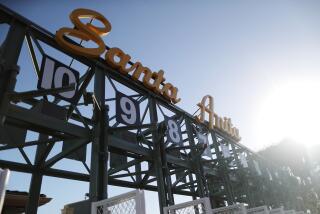Where the Money Goes at Pimlico
- Share via
In 1990, nearly a quarter of a billion dollars was bet at Pimlico Race Course.
What happens to all this money?
Of the $234,071,757 wagered, about 80 percent, or $187,532,497, was returned to the fans who made winning bets.
That left $46.5 million that was split nearly 50-50 between the track and the horsemen.
Of that $46.5 million, about half, or $23.9 million, went into purses--the prize money that goes to the winning horses.
The track ended up with $20.7 million after state taxes, contributions to the Breeders’ Fund and to the track employees’ pension fund were subtracted. But the track also took in an additional $10 million from admissions, program sales, parking, concessions and television contracts from the Pimlico Special and Preakness.
That meant Pimlico’s owners collected nearly $30 million in racing revenues. But they spent $28 million in racing-related expenses, such as an annual salary of $194,000 for track head Joseph A. De Francis, who gets a similar paycheck from Laurel for a combined annual salary of $388,000. Another $2.7 million went to pay interest on the $24.4 million loan the owners borrowed to buy the track. The end result: a $483,972 loss.
Of the money allotted for purses, 83 percent goes into purses for the daily racing cards and 17 percent is allocated for stakes -- the races that involve the most prize money.
When the track wants to increase a purse for a stakes race, like the increase last year for the Pimlico Special from $750,000 to $1 million, or a $250,000 purse for a new race like the De Francis Dash, the track kicks in the added money if the stakes money exceeds the 17 percent allocated from the horsemen’s purse account. De Francis said a large chunk of the track’s expenses last year went into purse increases for such stakes.
More to Read
Go beyond the scoreboard
Get the latest on L.A.'s teams in the daily Sports Report newsletter.
You may occasionally receive promotional content from the Los Angeles Times.










